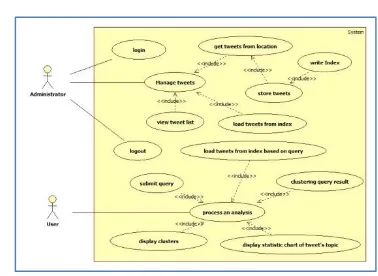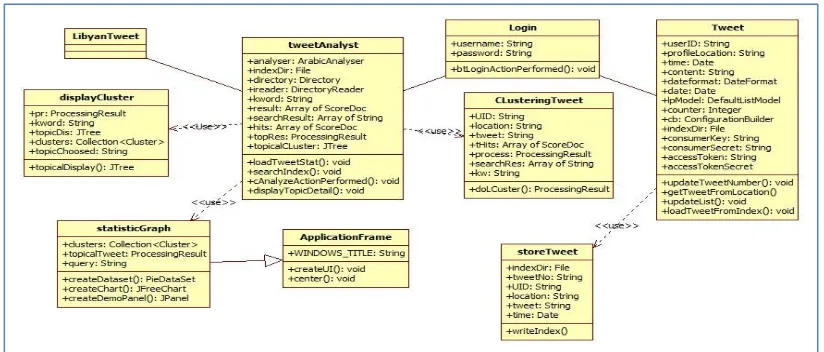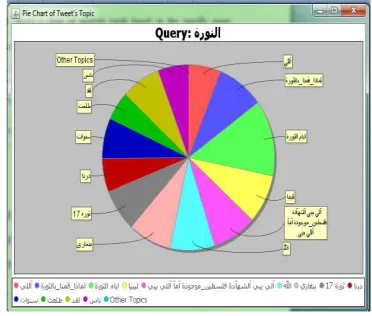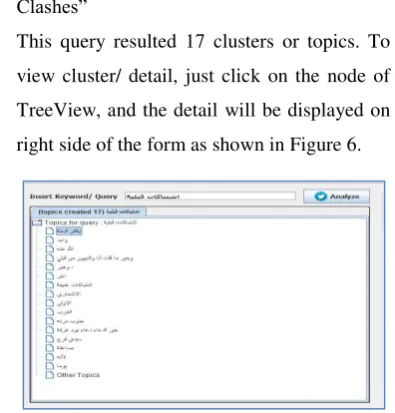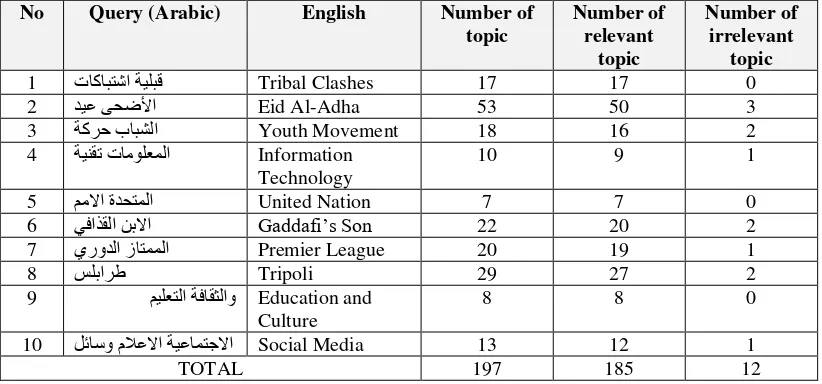1
DEVELOPING TOPICAL CLUSTERING OF LIBYAN’S
TWEETS USING CARROT
2FRAMEWORK
Moammar Mohamed Abdalmjied, Selo Sulistyo, Adhistya Erna Permanasari
Department of Electrical Engineering and Information Technology
Faculty of Engineering of Gadjah Mada University
Email:
[email protected]
,
[email protected]
,
[email protected]
Abstract
Today, Twitter in addition has become a way of life also has become one of the sources of data in a very large number that can be accessed by anyone and anytime as long as it is connected to the internet. Data twitter is now widely used for various purposes, e.g. for the purposes of the survey. As we know that today many organizations, both government and non-government have been utilizing Twitter as a data source. In this study, developed an application to analyze data or tweets twitter committed by the Libyan people, where most of the tweets are written in letters and Arabic. The results of the analysis are expected to be topics of conversation among the Libyan people on Twitter.
Development is done by utilizing Carrot2 Framework, where the stages of analysis and design are done by using the object-oriented approach utilizing UML. In addition, the application also utilizes several open libraries, such as Apache Lucene is useful for the process of indexing and retrieval and also Twitter4J tweets, a useful library API to access tweets from Twitter.
The resulting application is then tested with multiple queries, and the results of these tests can then be calculated degree of accuracy in the system generate topics of conversation. With 10 queries, system generates 197 topics, which 185 topics are relevant while the 12 topics considered irrelevant. So the accuracy of the system can be calculated and the results obtained 93.91. It can be concluded that the accuracy of the system in generating relevant topics is 93.91%.
Introduction
Today, twitter has become life style. It is
through twitter that People all over the world can
communicate and share their opinions and
thoughts. The twitter’s user can post million of
posts in short messages every day. I would argue
that tracking all messages and conversations that
posted by friends as a whole is almost tedious and
impossible.
During Libya’s revolution, social media such
as facebook and twitter have become the Libyans
means of communications to express their protest
against their government. As tension in the region
increased and social media continued to play a
significant role in the escalation of the Libyan
leader, Muammar Gaddafi, he cautioned his
citizens to hinder their Facebook usage. Activist
groups used the social network as well as Twitter
to call for reform and support the efforts of
Egypt’s own digital revolutionaries [1]. After the
fall of the regime of Muammar Gaddafi, the
Libyan people continue to use twitter to make
voice for their aspirations, criticizing the
government and calling for a better life
expectancy based on peace and justice.
With the increasing number of Twitter’s user
in Libya, then the study to find out what Libyan
talk about in Twitter have become important
factor to be. By knowing what topics that Libyan
talk on Twitter, it can be seen on the current
issues that occur in the middle of the Libyan
people. These issues can be very useful for
Government or private institutions in Libya for a
variety of interests. So far, studies have not been
conducted to determine issues that arise in Libya
by investigate the Libyan tweets on Twitter.
Carrot2 Framework is an Open Source
framework that provides several integrated
component that allows us to develop clustering
2 such as apache lucene that very useful and
powerful for indexing text and text retrieval that
can process text in a large amount very quickly.
Carrot2 also supported some clustering
algorithms that have been integrated in it, such as
Suffix Tree Algorithm (STC), K-Means, and
LINGO.
There are some research that compared thee
algorithm. S. Osinski & D. Weiss (2003) on a
research titled “Conceptual Clustering using
LINGO Algorithm: Evaluation on Open Directory
Project Data” concluded that that Lingo does a
decent job at separating topics present in search
results and labels them informatively compared
with STC and K-Means [2]. Other research in
2013 by R. Mahalakshmi & V. L. Praba titled “A
Relative Study on Search Results Clustering
Algorithms - K-means, Suffix Tree and LINGO” utilizing the Carrot2 Framework and Apache
Lucene; an application will be built to cluster
topics of the conversation. The main reason
underlying the use of the Carrot2 Framework and
Apache Lucene is due to both of them support the
analysis of text written in Arabic and most of
Libyan send tweets on Arabic.
Literature Review
There are several studies that have been done
before associated with this study. On 2011 K.D.
Rosa et al [4] presented a study on
automatically clustering and classifying Twitter
messages, also known as “tweets”, into
different categories, inspired by the approaches
taken by news aggregating services like Google
News. The experiment with ways of clustering
tweets into six predefined topics: News,
Sports, Entertainment, Science, Technology,
Money, and “Just for Fun”. To define the clusters,
they leverage popular hash-tags that appear in
perspective, but utilizing a supervised
methodology that utilize the hash-tags as
indicators of topics produce surprisingly good
results. This study also offer a discussion on
temporal effects of the methodology and
training set size considerations. Lastly, the
study also describe a simple method of finding the
most representative tweet in a cluster, and provide
an analysis of the results.
A study titled “Clustering Users in Twitter
Based on Interests” in 2012 also discuss about
clustering on twitter’s data ot tweets [5]. This study investigate the problem of clustering users
in Twitter based on their interests. Solving
this problem is very important in many
different fields, such as user recommendation,
personalized services, viral marketing, etc.
To address this problem, the author first
calculate user similarity leveraging both textual
contents and social structure, according with
Twitter’s role, not only a news media but also a
social network. These features include tweet text,
URLs, hashtags, following relationship and
retweeting relationship, all of them are closely
correlated with user’s interests. Then by using user similarity as a measure to cluster users. To
assess effectiveness of our method, we
3 Experimental results show that our method can
successfully cluster users in Twitter, and get a
much better performance than random selection.
Experimental results show that the method
can successfully cluster users in Twitter, and
performs much better than random selection.
From a side view, our experiment also shows
that users in the dataset of Twitter can be
approximately categorized into 400 clusters.
Other study that also associated with the
study that will be done is a study titled
“Delineating Real-Time Events by Identifying
Relevant Tweets with Popular Discussion Points”
by M.A. H. Khan et al (2013) [6]. This study
proposed a n unsupervised method for
recommending search users a set of tweets that
best delineate an ongoing public event. The
proposed graph-based retrieval algorithm is based
on a hypothesis that the discussion points that are
common among majority of event-relevant tweets
are motivated by the important occurrences of the
ongoing event. Hence, by identifying the popular
discussion points in a collection of event-relevant
tweets, and retrieving tweets comprising those
discussion points, it is possible to outline
real-time events. Further perform topical clustering on
the relevant tweets before applying the retrieval
algorithm on each topic cluster, so that, users
interested in a particular aspect of the event can
dig deeper into the search results returned for that
particular cluster. Evaluation performed on about
270,000 relevant tweets generated during a
real-world event reveals that, the tweets recommended
by the proposed model could delineate the
proceeding of the event with high precision and
recall and could also outperform two intuitive and
competitive baseline models.
The difference between the study to be
conducted with the studies described above are on
the methodologies used to solve the problem and
the data that will be analyzed. The study to be
conducted will be focused on data of Libyan’s
tweets. By utilizing Carrot2 Framework an
application will be developed.
Research Method
1. Analysis
System Architecture
Figure 1 show the system architecture that
will build in this study. From Figure 1 can be
seen that Twitter’s data or tweets accessed
from Twitter based on the query from
administrator utilizing Twitter4J library. The
Twitter data then will be processing utilizing
Apache Lucene Library to produce index that
will be store into the system’s storage. In the
other side, when user submit a query in order
to get the topical cluster of tweets, the query
will processed on feature extraction process.
This process will access data from storage.
Feature resulted from this process will be
processed on the next step in order to produce
cluster and cluster’s content. At last, the result
will be presented to user as topical cluster of
tweets.
4 Table 1 System Requirement List
Actor Requirement
Administrator 1) Administrator can log into the system.
user User can process an analysis The main purpose of this system development is to produce an application that can be used to analyze and generate topics of tweets in the form of clusters. To process an analysis, there are several use cases that will be included, namely:
a) Submit query
b) Load tweets from index based on query
c) Clustering query result d) Display clusters
e) Display statistic chart of
tweet’s topic System Requirement Analysis
Table 1 presents a list of system requirement
for each user that involved in the system. There
are two actors in the system, namely administrator
and user. System’s requirement for each actor
have been presented on Table 1.
1) Design
Figure 2 shows the use case diagram of the
system. From Figure 2 can be seen that there are
two actors in the system, administrator and user.
Administrator’s role is to manage tweets.
While the user is using the system for the purpose
of obtaining a particular analysis where the
analysis is based on their needs using tweets
stored in the index.
Figure 2 Use case diagram
Refer Figure 2 it also can be seen that the
administrator access of twitter tweets from a
particular location. In this case, a particular
method of accessing is used, so the tweets coming
from specific locations can be accessed in real
time and stored in the index. Therefore, the use
case get tweets from location also will include a
use case store index that also will ultimately
involve the use case write index into the index
store and write tweets into index.
In his role managing tweets, then the
administrator has the authority to enter into the
system, in this case must first pass through the
login process. If the administrator can log into the
system, the administrator can also log out of the
system.
The role of the actor in the specific user is
interested parties to use the system to perform a
specific analysis based on their needs, which in
this case is done by inserting a specific query. As
already detailed in Table 1, that the analysis
results, there are stages that will be done of the
system. These stages are the steps to do in doing
clustering using Lingo algorithm. Own analysis
results will be displayed in the form of a specific
visualization, for example: charts, tree, or any
5 user to read and understand the topics generated
from this analysis easily.
Class diagram of the system to be developed
is shown by Figure 3. From Figure 3 can be seen
the relation between classes of the system. As
described on table 4.3 that LibyanTweet is the
main class that will executed first when the
system run. This main class will call tweetAnalyst
class, and the relation between these classes is
association. To perform tweets analysis and
display the result in tree view and chart,
tweetAnalyst uses these classes: 1) CLusteringTweet
tweetAnalyst use this class to perform
clustering of tweets. Based on the query
entered by users, system will load query
result or search result that stored in array of
string which will be forwarded into
CLusteringTweet as a parameter. And then
CLusteringTweet will cluster using
doCluster() method that will send
processingResult as a return value to
tweetAnalyst. 2) displayCluster
The clustering result then will be send to
displayCluster class to create cluster display
in tree view form.
3) statisticGraph
The analysis result also will send to this
class in order to create cluster’s display in a chart. This class inherit the properties and
behavior of ApplicationFrame. The relation
type between statisticGraph and
ApplicationFrame is generalization.
Furthermore, tweetAnalyst also has an association
relationship with login in which Tweet class has a
dependency on it. In order to manage tweets,
Tweet class will use storeTweet to write tweets
into index.
2. Result and Discussion Result
The purpose of this system development is to
analyze the tweets sent by Twitter users who are
in the areas of Libya, which of course most of the
tweets were written in Arabic language and
writing. Therefore, in the analysis, the authors
need library that support Arabic language text
analysis and in Arabic writing. The analysis is
meant here is how to determine the topics in
tweets using the clustering method. Carrot2
6 problem, in which in addition to providing a
variety of useful features to make text clustering,
also support the analysis of text written in Arabic
language and writing.
To perform tweets analysis, there are classes
that will be used which have specific function.
These classes are as follows: 1) tweetAnalyst.java
This class is a class that inherits properties
and behaviors of JFrame class in Java. The
JFrame class is used as a top-level container
for the graphical components of a graphical
user interface (GUI). Figure 4 shows the
GUI’s display of tweetAnalyst.java.
2) CLusteringTweet.java
CLusteringTweet.java is the most important
class in the clustering process to generate
topics of conversation in the tweets from the
search results. Search results transmitted by
tweetAnalyst.java then will be stored into
variable called searchRes. It is would then
be converted into a List of the Document
called documents. Document is a class that
included in Carrot2 Framework which is
also a type of data, which serves to store the
data sources to analyzed. 3) clusterDisplay.java
This class used to produce TreeView of
clusters. To produce TreeView, this class
has a method called topicalDisplay() that
will return value with type JTree. JTree is a
GUI component of java to display list in a
TreeView. The ProcessingResult that sent
via parameter then stored in a variable called
pr. First on the top of this class, a Collection
of Cluster called clusters has defined.
Statement “clusters = pr.getClusters();” used
to access and store all clusters in variable pr
into variable clusters. After all cluster
stored, then there will a looping to determine
every cluster as node of tree. So that the
TreeView will display the label formed
cluster, and the cluster labels are generated
topics.
4) statisticGraphic.java
In these developed applications, in addition
to the analysis results are displayed in the
TreeView, is also presented in chart form. In
the implementation, statisticGraphic was
extending ApplicationFrame class. This
mean that statisticGraphic will inherits
properties and behavior of
ApplicationFrame class. ProcessingResult
parameter than will be processed to produce
dataset. A dataset is a data source to create a
chart. Figure 5 shows a pie chart of analysis
result based on the specific query entered by
user.
Figure 4 GUI’s display of
tweetAnalyst.java
7 5) ApplicationFrame.java
ApplicationFrame.java is a class to create
frame to display the chart generated. This
class extends JFrame class of java, a GUI
component to create frame form.
Discussion
a) Analysis of the Result
Analysis of result will be conducted by
analyze several topics resulted by system
based on specific query and compare the result
by consider the real condition during the
period of accessing tweets from twitter. Table
4.1 presents tweets access information about
tweets that has been stored in index.
Here is an analysis of the topics generated based
on specific queries:
1) Query : “تاكابتشا ةيلبق” or “Tribal
Clashes”
This query resulted 17 clusters or topics. To
view cluster/ detail, just click on the node of
TreeView, and the detail will be displayed on
right side of the form as shown in Figure 6.
2) Query : “ديعىحضلأا” or “Eid Al-Adha”
There are a lot of tweets that talked about this.
Using this query, system resulted 53 topics as
shown in Figure 7.
Based on the discussion of some topics
generated from the queries above, it can be
concluded that most of the topics that are
produced can be said to be relevant to the query is
entered. However, there are some topics that felt
irrelevant and has no meaning. See Figure 4.18
for example. Topic “RayanBanoun” when we
click on the node of TreeView, can see the detail
of this topic as shown in Figure 4.19. This topic is
generated because the tweets were found
contained the word "RayanBanoun" or
"RayanBanoun". Character "@" will be
eliminated by Carrot2 Framework when passing
through the preprocessing stage. Actually
RayanBanoun is the profile name of the twitter
user. And if we look carefully, we can see that
twitter user with the profile name "RayanBanoun"
is mentioned several times by other twitter users.
Other examples can also be seen in Figure
4.18. In the TreeView there is a topic "هههههههه" which if translated into English as "Hahahaha". It
is an expression of laughter. And of course not
relevant when used as a topic. Just like the topic
"RayanHanoun", this topic generated because the Table 2 Tweets access information
Number of
tweets
17.289 tweets
Start date 27th September 2014 End Date 14th October 2014
Figure 6 TreeView of Topical Cluster with
query “تاكابتشاةيلبق”
8 tweets are grouped in this topic contains the word
"هههههههه".
Framework Carrot2 actually define the words
that are considered as the stopword to be removed
when passing through the preprocessing stage.
But words like "هههههههه" of course not included as a stopword. For those reasons, the resulting
system still needs to be improved so that the
preprocessing stage is necessary to add another
stage to filter out words that are not included in
the stopword defined by Carrot2 Framework. For
example, when a user in a tweet mentioning the
profile name of the other user, it should be called
the profile name be removed when passing
through the stages of preprocessing. So that is
stored in the index should just tweet the contents
of the user.
b) Accuracy Testing
Taking into account the discussion conducted
in the segment analysis of results above, this
segment will be measured on how the accuracy of
the system in generating relevant topics.
Measurement of accuracy is done by assessing
each topic generated by several queries and then
determines whether the topic is relevant or not.
Accuracy percentage will be calculated based on
the ratio between the numbers of topics relevant
to the numbers of topics that are not relevant.
Table 3 presents list of queries that will be
used to measure the accuracy of the system also
the summary of testing result by each query.
From Table 4.3 showed that the overall
number of topics is 197 topics, where 185 topics
are considered relevant and 12 irrelevant topics.
From this data, the level of accuracy can be
calculated as follows:
So it can be concluded that the accuracy of
the system in analyzing tweets and generating
relevant topics is 93.91%.
3. Conclusion
Social media no doubt has brought
enormous influence in many aspects of life.
At the time of the revolution in Libya, social
media such as twitter and other has become
effective media for interaction and
communication in performing the movement.
Even at this point too, passed a few years
after the revolution, social media such as
twitter has become the Libyan’s lifestyles.
Libyan people use twitter for various reasons,
such as lifestyle, as a medium to
communicate and interact, as a medium to 𝐴𝑐𝑐𝑢𝑟𝑎𝑐𝑦
= 𝑛𝑢𝑚𝑏𝑒𝑟 𝑜𝑓 𝑟𝑒𝑙𝑒𝑣𝑎𝑛𝑡 𝑡𝑜𝑝𝑖𝑐𝑠𝑛𝑢𝑚𝑏𝑒𝑟 𝑜𝑓 𝑜𝑣𝑒𝑟𝑎𝑙𝑙 𝑡𝑜𝑝𝑖𝑐𝑠 𝑥 100
=185197 𝑥100 = 93.91%
topic topic
1 تاكابتشاةيلبق Tribal Clashes 17 17 0 2 ديعىحضلأا Eid Al-Adha 53 50 3 3 ةكرحبابشلا Youth Movement 18 16 2 4 ةينقتتامولعملا Information
Technology
10 9 1
5 مملااةدحتملا United Nation 7 7 0 6 يفاذقلانبلاا Gaddafi’s Son 22 20 2 7 يرودلازاتمملا Premier League 20 19 1 8 سلبارط Tripoli 29 27 2 9 ميلعتلاةفاقثلاو Education and
Culture
8 8 0
10 لئاسوملاعلااةيعامتجلاا Social Media 13 12 1
9 express ideas and concepts, as the media to
criticize government policies, etc.
Based on the above facts, in this study
developed a system or application that can be
used to analyze tweets or twitter the data sent
by the Libyan people. The result of this
analysis is in the form of topics being
discussed by the Libyan community on
twitter by a certain issue. By knowing the
various topics of conversation on a particular
issue that is going on, then this will be a boon
for those who need this kind of analysis, such
as government, non-governmental
organizations and others.
In the stages of analysis and system design,
object-oriented approach used utilizes the
Unified Modeling Language (UML). At the
analysis stage, is the determination of the
architecture of the system to be built and
analyzed what the functional requirements
that must be met by the system. Furthermore,
based on the results of the analysis, the
system design was developed. The system
design is done by modeling the system into
UML diagrams, such as use case diagrams,
activity diagrams, sequence diagrams, and
class diagrams.
The process of developing this system
utilizes libraries provided by the open source
libraries such as Carrot2 Framework, Apache
Lucene, and Twitter4J. Twitter4J useful in
accessing tweets from twitter. While Apache
Lucene is useful in the process of tweets
indexing and tweets retrieval based on user’s
query. And Carrot2 Framework tweets used
to process search results clustering, where
clustering is done using the Lingo algorithm
provided by this framework. Both Apache
Lucene and Carrot2 Framework already
support the processing and analysis of text in
Arabic language and writing. This is the
entering certain queries and then performed
an analysis of the topics generated. It can be
concluded that the topics generated still
found irrelevant topics. This is because there
are certain words contained in the tweets that
are not included in the Arabic stopword list,
Considering the above, then in the discussion
phase is necessary to test the accuracy of the
system by measuring the level of relevance of
the topics generated. Tests conducted on
topics generated by using 10 queries. With 10
queries, system generates 197 topics, which
185 topics are relevant while the 12 topics
considered irrelevant. So the accuracy of the
system can be calculated and the results
obtained 93.91. It can be concluded that the
accuracy of the system in generating relevant
topics is 93.91%.
References
[1] M. McHugh. (2011). “Libya Inspired By Egyptian Revolution, Uses Social Media in
Midst of Protests”.
“Conceptual Clustering using LINGO
10 http://www.cs.put.poznan.pl/dweiss/site/pu
blications/download/iipwm-osinski-weiss-2004-lingoeval.pdf
[3] R. Mahalakshmi & V. L. Praba. (2013). “A Relative Study on Search Results Clustering Algorithms - K-means, Suffix
Tree and LINGO”. International Journal
of Engineering and Advanced Technology (IJEAT) ISSN: 2249 – 8958, Volume-2, Issue-6, August 2013.
[4] K.D. Rosa, R. Shah,B. Lin, A. Gershman
& R. Frederking. (2011). “Topical Clustering of Tweets”.
http://www.cs.cmu.edu/~encore/sigir_sws m2011.pdf
[5] Anonymous. (2011). “Clustering Users in
Twitter Based on Interests”.
http://www.nlpr.ia.ac.cn/2011papers/gnhy/
nh4.pdf.
[6] M.A. H. Khan, G. Liu, D. Bollegala and K.
Sezaki. (2013). “Delineating Real-Time Events by Identifying Relevant Tweets
with Popular Discussion Points”.

